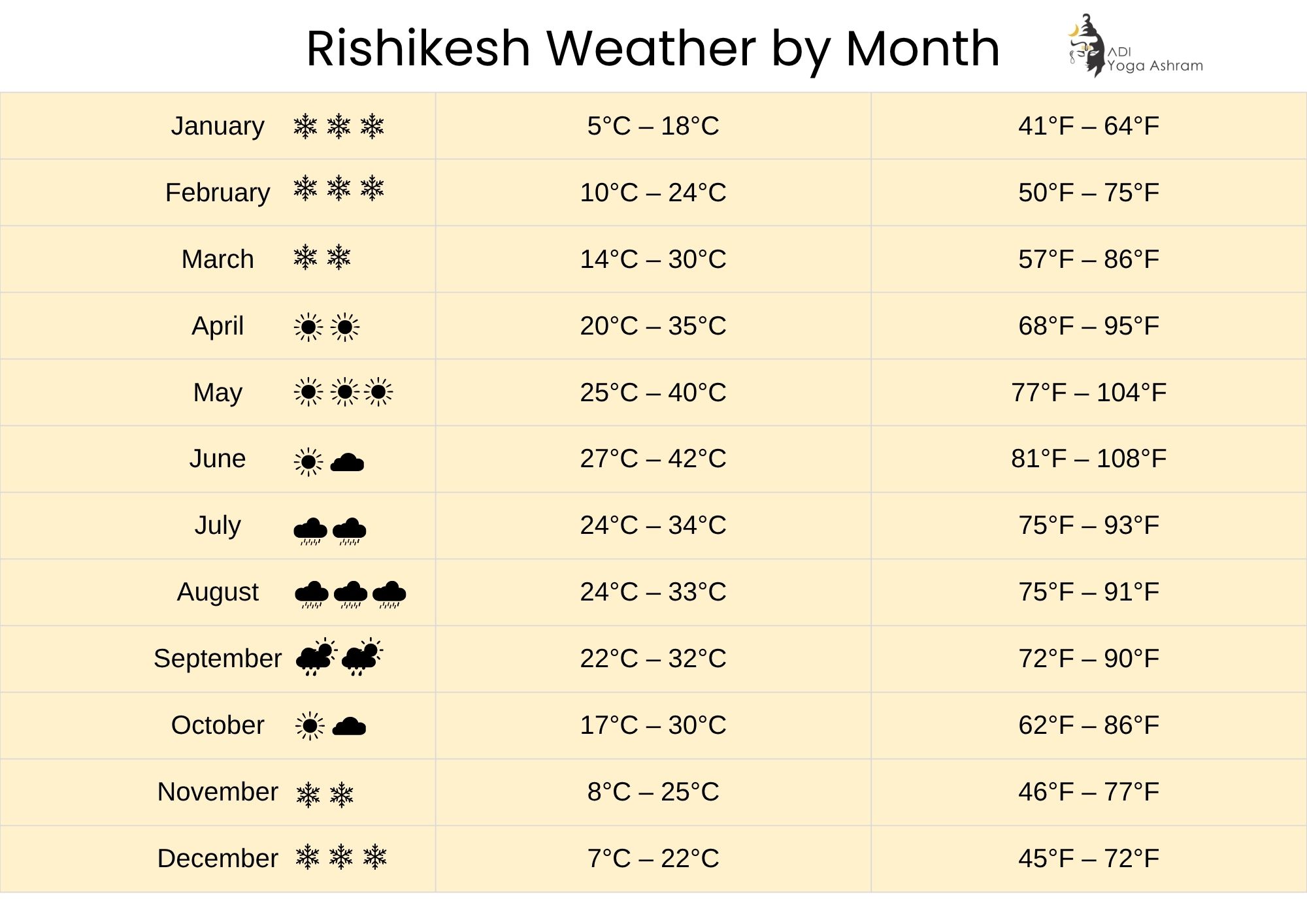One of the most well-known and frequently visited cities in Uttarakhand, a state in northern India, is Rishikesh. It is well-known for its serene settings, abundance of yoga schools, and meditative vibe. The town offers a blend of peaceful riverside living and mountain vegetation because it is located next to the Ganga River in the foothills of the Himalayas. It makes it ideal for both yoga practitioners and all types of tourists. However, it’s helpful to know the Best Time to visit Rishikesh before you go. The city experiences a variety of seasonal fluctuations, including hot summers, nice winters, and a cool but occasionally intense monsoon. Therefore, being aware of the weather might improve the comfort and enjoyment of your trip.
Overview of Rishikesh Climate
Rishikesh has a continental climate. That means summers can be very hot, and winters can get freezing, and the monsoon sometimes brings extreme rain. The city sits at about 372 meters above sea level, so it’s relatively cooler than the plains but warmer than the higher Himalayas.
So let’s take a look at Rishikesh’s weather month by month.
Rishikesh Weather Month by Month

January
Temperature: 5°C – 18°C
January is the season of peak winter in Rishikesh. Mornings can be foggy and chilly, while afternoons bring mild sunshine if you’re lucky. Warm clothes are a must, especially in the early mornings and at night. Most travellers avoid the cold, so the city stays quiet and less crowded. This makes it a peaceful time for meditation, yoga practice, and visiting temples without any rush.
February
Temperature: 10°C – 24°C
In February, the air starts to warm up slightly. Days become pleasant, though nights remain cool. February is perfect for outdoor walks, exploring temples, or sitting by the river in the sun. If you don’t enjoy freezing cold weather, this month might be ideal for you. Tourist numbers begin to increase a little, but the city still feels calm and relaxed.
March
Temperature: 14°C – 30°C
March brings spring to Rishikesh. The weather feels balanced — not too hot, not too cold. It’s an excellent month for yoga, sightseeing, and adventure sports like white-water rafting, which starts mid-March. The famous festival of colors, Holi, is also celebrated this month, adding joy and energy to the city. Expect moderate crowds, as both domestic and international travelers start arriving.
April
Temperature: 20°C – 35°C
April brings longer days and warmer sunshine. Early mornings and evenings stay pleasant, but afternoons can get quite hot. It’s a wonderful month for café visits, river walks, and short treks in nearby hills. As the temperature rises, Rishikesh starts getting busier again with yoga courses and tourist groups returning.
May
Temperature: 25°C – 40°C
May is one of the hottest months in Rishikesh. Mornings are fine for outdoor activities, but afternoons can feel dry and humid. The city becomes crowded as schools across India close for summer holidays. Many families travel to Rishikesh and nearby Himalayan temples like Badrinath and Kedarnath. Expect traffic and packed hotels. If you could describe May in two words, they’d be “heat” and “crowds.”
June
Temperature: 27°C – 42°C
June can be unpredictable. Some years it feels like an extension of May; other times the monsoon begins earlier, bringing light showers that cool the air. These occasional rains refresh the dry hills and make the landscape green again. By the end of the month, the weather starts changing, preparing for heavy rain in July. Tourist traffic begins to drop as people avoid traveling during the monsoon.
July
Temperature: 24°C – 34°C
July is the heart of the monsoon season. Rain is frequent, sometimes heavy. Rafting and most adventure activities pause for safety reasons. The city, however, turns lush and beautiful. July also brings the Kanwar Yatra, a major religious pilgrimage. Hundreds of thousands of devotees travel through Rishikesh on their way to Neelkanth Mahadev Temple. Traffic becomes congested, and movement across the city can be difficult due to the massive crowds. It’s a fascinating time culturally, but not ideal for tourism.
August
Temperature: 24°C – 33°C
August continues the rainy season, sometimes reaching its peak. Showers can last for hours or arrive suddenly. The hills turn deep green, and the Ganga flows strong. However, heavy rainfall can cause landslides in the nearby region, delaying travel plans. Because of this, many tourists skip August, but those who do visit enjoy quiet retreats and less crowded ashrams. It’s a good month for reflection and peaceful stays.
September
Temperature: 22°C – 32°C
The rain begins to fade, and Rishikesh feels fresh again. Skies clear up, and the temperature becomes comfortable. Tourist activity slowly returns, and yoga schools start new teacher training batches. September is one of the best months to join Yoga Teacher Training Programs, as classes are smaller and the weather supports consistent outdoor practice.
October
Temperature: 17°C – 30°C
October is one of the most pleasant months in Rishikesh. The humidity disappears, the sky stays blue, and the days feel comfortably warm. Nights can be slightly cool, so packing a light jacket is smart. Rafting season officially resumes, and the city becomes lively again. This is considered the peak travel season, so booking accommodations in advance is a good idea.
November
November is cool, sunny, and peaceful. Mornings and evenings need light woollens, but the days are warm enough for sightseeing and outdoor yoga. The weather is perfect for long-term yoga courses, workshops, and ashram stays.
One of the biggest festivals in India, Diwali (Deepawali), usually falls in October or November. During this time, Rishikesh lights up beautifully with lamps along the river, special prayers at the ghats, and evening fireworks. The city becomes vibrant, and the festive atmosphere attracts many visitors. Traffic can increase slightly, but it’s worth experiencing the celebration by the Ganga.
December
Temperature: 7°C – 22°C
December brings cold mornings and crisp nights. Fog is common at sunrise, and the Ganga looks calm under the winter light. Heavy woollens are necessary if you plan early morning practices or late evening walks. Tourist numbers drop again, leaving the city quiet and slow-paced. It’s a peaceful month for introspection, writing, and relaxation — a good time for those who prefer calm over crowds.
Best Time to Visit Rishikesh
If you want the most comfortable weather, the best time to visit Rishikesh is February to April and September to November.
Here’s a quick summary by interest:
- Yoga & Spiritual Practice: January to April, September to December
- Adventure & Rafting: March to early May, and October
- Peaceful Retreats: July and August (quiet monsoon months)
- Photography & Winter Walks: December to February
Travel Tips for Every Season
- Winter (Dec–Feb): Pack woollens. Early mornings and late nights are cold.
- Summer (Apr–Jun): Carry sunscreen, a hat, and drink plenty of water.
- Monsoon (Jul–Aug): Bring rain gear and check road conditions.
- Autumn (Sep–Nov): Great for rafting and yoga retreats; book in advance.
Rishikesh is worth visiting in any season, but the experience changes with the weather. Winter feels calm and spiritual, summer brings energy and activity, and the monsoon shows nature at its most vibrant.
If you plan your trip around your interests and comfort, the weather will fit right in. Whether it’s yoga by the river, white-water rafting, or simply watching the sunset over the hills, Rishikesh always has something special waiting.
And suppose you are planning to join a yoga program, we at Adi Yoga Ashram. In that case, we offer a Yoga Alliance-registered 200 Hour Yoga TTC and 300 Hour Yoga TTC and short-term Yoga Retreats in Rishikesh, where you can learn this practice in a supportive environment.

